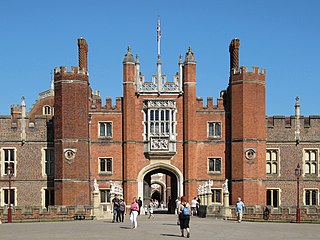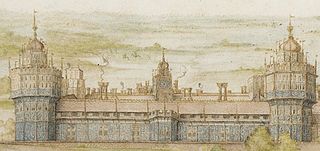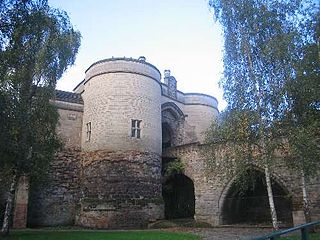 W
WThe Palace of Beaulieu is a former Royal Palace in Boreham, Essex, England, north-east of Chelmsford. The surviving part is a Grade I listed building. The property is currently occupied by New Hall School.
 W
WEltham Palace is a large house at Eltham in southeast London, England, within the Royal Borough of Greenwich. The house consists of the medieval great hall of a former royal residence, to which an Art Deco extension was added in the 1930s. The hammerbeam roof of the great hall is the third-largest of its type in England, and the Art Deco interior of the house has been described as a "masterpiece of modern design". The house is owned by the Crown Estate and managed by English Heritage, which took over responsibility for the great hall in 1984 and the rest of the site in 1995.
 W
WGreenwich Castle was a hunting lodge used during the reign of Henry VIII, located in Greenwich Park, in Greenwich, England. The Royal Observatory, Greenwich now stands on the site. Greenwich Castle was apparently a favourite place for Henry VIII to house his mistresses, as it was within easy travelling distance of Greenwich Palace at the foot of the hill.
 W
WThe Palace of Placentia, also known as Greenwich Palace, was an English royal residence that was initially built by Humphrey, Duke of Gloucester, in 1443. It was located at Greenwich on the bank of the River Thames, downstream from London. The original residence was extensively rebuilt around 1500 by Henry VII. In 1660, it was demolished by Charles II to make way for a proposed new palace, which was never constructed. Nearly forty years later, the Greenwich Hospital was built on the site.
 W
WHampton Court Palace is a Grade I listed royal palace in the London Borough of Richmond upon Thames, 12 miles south west and upstream of central London on the River Thames. Building of the palace began in 1515 for Cardinal Thomas Wolsey, a favourite of King Henry VIII. In 1529, as Wolsey fell from favour, the cardinal gave the palace to the king to check his disgrace. The palace went on to become one of Henry's most favoured residences; soon after acquiring the property, he arranged for it to be enlarged so that it might more easily accommodate his sizeable retinue of courtiers. Along with St James' Palace, it is one of only two surviving palaces out of the many the king owned. The palace is currently in the possession of Queen Elizabeth II and the Crown.
 W
WHatfield House is a country house set in a large park, the Great Park, on the eastern side of the town of Hatfield, Hertfordshire, England. The present Jacobean house, a leading example of the prodigy house, was built in 1611 by Robert Cecil, 1st Earl of Salisbury and Chief Minister to King James I, and has been the home of the Cecil family ever since. It is a prime example of Jacobean architecture. The estate includes extensive grounds and surviving parts of an earlier palace. The house, currently the home of Robert Gascoyne-Cecil, 7th Marquess of Salisbury, is open to the public.
 W
WNonsuch Palace was a Tudor royal palace, built by Henry VIII in Surrey, England; it stood from 1538 to 1682–83. Its site lies in what is now Nonsuch Park on the boundaries of the borough of Epsom and Ewell in Surrey and the London Borough of Sutton.
 W
WNottingham Castle is a castle in Nottingham, England, in a commanding position on a natural promontory known as "Castle Rock", with cliffs 130 feet (40 m) high to the south and west. In the Middle Ages it was a major royal fortress and occasional royal residence. In decline by the 16th century, it was largely demolished in 1651. The Duke of Newcastle later built a mansion on the site, which was burnt down by rioters in 1831 and left as a ruin. It was later rebuilt to house an art gallery and museum, which remain in use. Little of the original castle survives, but sufficient portions remain to give an impression of the layout of the site.
 W
WOatlands Palace is a former Tudor and Stuart royal palace which took the place of the former manor of the village of Oatlands near Weybridge, Surrey. Little remains of the original building, so excavations of the palace took place in 1964 to rediscover its extent.
 W
WOtford Palace, also known as the Archbishop's Palace, is in Otford, an English village and civil parish in the Sevenoaks District of Kent. The village is located on the River Darent, flowing north down its valley from its source on the North Downs.
 W
WThe Palace of Placentia, also known as Greenwich Palace, was an English royal residence that was initially built by Humphrey, Duke of Gloucester, in 1443. It was located at Greenwich on the bank of the River Thames, downstream from London. The original residence was extensively rebuilt around 1500 by Henry VII. In 1660, it was demolished by Charles II to make way for a proposed new palace, which was never constructed. Nearly forty years later, the Greenwich Hospital was built on the site.
 W
WRichmond Palace was a royal residence on the River Thames in England which stood in the sixteenth and seventeenth centuries. Situated in what was then rural Surrey, it lay upstream and on the opposite bank from the Palace of Westminster, which was located nine miles (14 km) to the north-east. It was erected about 1501 by Henry VII of England, formerly known as the Earl of Richmond, in honour of which the manor of Sheen had recently been renamed "Richmond". Richmond Palace therefore replaced Shene Palace, the latter palace being itself built on the site of an earlier manor house which had been appropriated by Edward I in 1299 and which was subsequently used by his next three direct descendants before it fell into disrepair.
 W
WSt James's Palace is the most senior royal palace in the United Kingdom. It gives the name, Court of St James's, to the monarch's royal court and is located in the City of Westminster in London. Although no longer the principal residence of the monarch, it is the ceremonial meeting place of the Accession Council, the office of the Marshal of the Diplomatic Corps, and the London residence of several minor members of the royal family.
 W
WThe Palace of Whitehall at Westminster, Middlesex, was the main residence of the English monarchs from 1530 until 1698, when most of its structures, except notably Inigo Jones's Banqueting House of 1622, were destroyed by fire. Henry VIII moved the royal residence here after the old royal apartments at the nearby Palace of Westminster were themselves destroyed by fire.
 W
WYork House was one of a string of mansion houses which formerly stood on the Strand, the principal route from the City of London to the Palace of Westminster.